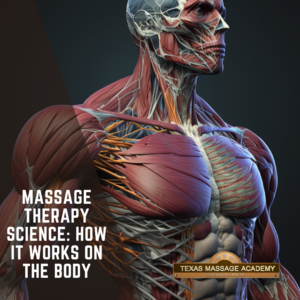As an Amazon Associate, I earn from qualifying purchases.

As humans, we are constantly seeking ways to alleviate pain and stress in our lives. Massage therapy is one of the most popular methods that have stood the test of time. This ancient practice dates back to 3000 BCE, and its popularity has grown over time. Today, massage therapy is a thriving industry that offers a range of benefits for the mind and body. But how does massage therapy work on the body? Let’s explore the science behind this healing practice.
What is massage therapy?
Before we dive into the science of massage therapy, it’s essential to understand what it is. Massage therapy is a hands-on manipulation of soft tissues in the body to relieve pain, tension, and stress. It involves pressing, rubbing, and manipulating muscles, tendons, ligaments, and other soft tissues. The therapist may use their hands, fingers, elbows, forearms, or tools to apply pressure.
There are different types of massage therapy, such as Swedish, deep tissue, sports, and more. Each type has its unique techniques and benefits. For instance, Swedish massage is known for its gentle, relaxing strokes that promote relaxation and stress relief. On the other hand, deep tissue massage uses more forceful pressure to work on deeper layers of muscles and connective tissues.
10 Benefits of Massage Therapy You Never Knew Existed(Opens in a new browser tab)
The Science behind Massage Therapy
Massage therapy may seem simple, but its effects on the body are complex and far-reaching. The science behind massage therapy involves a combination of physiological and psychological responses. Let’s take a closer look at how massage therapy works on the body.
- Increases Blood Flow
Massage therapy improves blood flow in the body by stimulating the circulatory system. The therapist’s hands create pressure on the soft tissues, which causes the blood vessels to dilate. This dilation allows more blood to flow to the muscles, organs, and other tissues. As a result, the body receives more oxygen and nutrients, which helps to repair and regenerate tissues.
- Releases Tension in Muscles
Muscle tension is a common cause of pain and discomfort in the body. Massage therapy works by releasing tension in the muscles. The pressure from the therapist’s hands helps to stretch and elongate the muscles, which reduces tension. As a result, the muscles become more relaxed and flexible, which improves the range of motion and reduces pain.
- Triggers the Parasympathetic Nervous System
Massage therapy has a calming effect on the body, which triggers the parasympathetic nervous system. This part of the nervous system is responsible for the “rest and digest” response, which helps to reduce stress and promote relaxation. When the parasympathetic nervous system is activated, the body’s heart rate and blood pressure decrease, and the muscles relax.
- Reduces Inflammation
Inflammation is a natural response of the body to injury or infection. However, chronic inflammation can cause pain and other health problems. Massage therapy has been shown to reduce inflammation in the body by reducing the levels of cytokines, which are proteins that cause inflammation. As a result, massage therapy can help to alleviate pain and reduce the risk of chronic diseases.
- Releases Endorphins
Endorphins are natural painkillers the body produces in response to stress or pain. Massage therapy stimulates the production of endorphins, which helps to reduce pain and promote relaxation. Endorphins also have a mood-boosting effect, which can improve mental health.
- Improves Lymphatic Drainage
The lymphatic system is responsible for removing waste and toxins from the body. Massage therapy can improve lymphatic drainage by stimulating the lymph nodes and vessels. This helps remove waste and toxins from the body more efficiently, boosting the immune system and improving overall health.
- Reduces Cortisol Levels
Cortisol is a hormone that the body produces in response to stress. High cortisol levels can cause various health problems, such as weight gain, anxiety, and depression. Massage therapy has been shown to reduce cortisol levels in the body, which helps to alleviate stress and improve mood.
- Increases Joint Mobility
Massage therapy can improve joint mobility by reducing stiffness and improving the range of motion. The pressure from the therapist’s hands helps to stretch and mobilize the soft tissues surrounding the joint. This can help to reduce pain and stiffness and improve joint function.
- Improves Sleep Quality
Massage therapy can improve sleep quality by promoting relaxation and reducing stress. The calming effect of massage therapy triggers the parasympathetic nervous system, which helps to reduce heart rate and blood pressure. This can lead to more restful sleep and improve overall sleep quality.
- Boosts Immune System
Massage therapy can boost the immune system by increasing blood flow and lymphatic drainage and reducing inflammation. By improving the body’s ability to remove waste and toxins, massage therapy can help to strengthen the immune system and improve overall health.
- Enhances Mental Health
Massage therapy has been shown to have a positive effect on mental health. Massage therapy’s calming effect can help reduce anxiety and depression and improve mood. Endorphins, the natural painkillers the body produces in response to massage therapy, can also have a mood-boosting effect.
- Alleviates Headaches
Headaches are a common problem caused by tension in the neck and shoulders. Massage therapy can alleviate headaches by reducing muscle tension in these areas. The pressure from the therapist’s hands can help to relax the muscles and reduce pain.
- Improves Digestion
Massage therapy can improve digestion by stimulating the digestive system. The pressure from the therapist’s hands can help stimulate the production of digestive enzymes, improving digestion and nutrient absorption. Massage therapy can also help reduce stress, improving digestive health.
- Reduces Scar Tissue
Scar tissue can form after an injury or surgery, which can cause pain and stiffness. Massage therapy can help reduce scar tissue by breaking up adhesions and increasing blood flow. This can improve the range of motion and reduce pain.
- Enhances Athletic Performance
Massage therapy can enhance athletic performance by reducing muscle tension and improving flexibility. The pressure from the therapist’s hands can help to elongate the muscles and increase the range of motion. This can improve athletic performance and reduce the risk of injury.
Conclusion
Massage therapy is a healing practice that has been used for thousands of years. Its benefits are numerous, ranging from physical to mental health. Massage therapy can improve blood flow, reduce muscle tension, boost the immune system, and enhance overall health and well-being by stimulating the body’s natural healing mechanisms. Whether you want to alleviate pain and stress or improve athletic performance, massage therapy is a safe and effective option worth exploring.
If you are ready to book a massage, give us a call at 325.646.4272 or book online at www.texasmassageacademy.com




